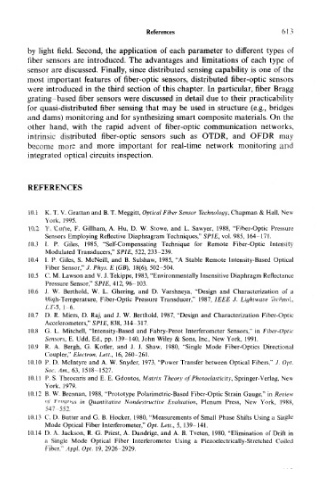Page 629 - Introduction to Information Optics
P. 629
References 61 3
by light field. Second, the application of each parameter to different types of
fiber sensors are introduced. The advantages and limitations of each type of
sensor are discussed. Finally, since distributed sensing capability is one of the
most important features of fiber-optic sensors, distributed fiber-optic sensors
were introduced in the third section of this chapter. In particular, fiber Bragg
grating-based fiber sensors were discussed in detail due to their practicability
for quasi-distributed fiber sensing that may be used in structure (e.g., bridges
and dams) monitoring and for synthesizing smart composite materials. On the
other hand, with the rapid advent of fiber-optic communication networks,
intrinsic distributed fiber-optic sensors such as OTDR, and OFDR may
become more and more important for real-time network monitoring and
integrated optical circuits inspection.
REFERENCES
10.1 K. T. V. Grattan and B. T. Meggitt, Optical Fiber Sensor Technology, Chapman & Hall New
York, 3995.
10.2 F. Corke, F. Gillham, A. Hu, D. W. Stowe, and L. Sawyer, 1988, "Fiber-Optic Pressure
Sensors Employing Reflective Diaphragram Techniques," SPIE, vol. 985, 164-171.
10.3 I. P. Giles, 1985, "Self-Compensating Technique for Remote Fiber-Optic Intensity
Modulated Transducers," SPIE, 522, 233-239.
10.4 I. P. Giles, S. McNeill, and B. Sulshaw, 1985, "A Stable Remote Intensity-Based Optical
Fiber Sensor," J. Phys. E (GB), 18(6), 502-504.
10.5 C. M. Lawson and V. J. Tekippe, 1983, "Environmentally Insensitive Diaphragm Reflectance
Pressure Sensor," SPIE, 412, 96-103.
10.6 J. W. Berthold, W. L. Ghering, and D. Varshneya, "Design and Characterization of a
High-Temperature, Fiber-Optic Pressure Transducer," 1987, IEEE J. Lightwave Tectmoi,
LT-5, 1 -6.
10.7 D. R. Miers, D. Raj, and J. W. Berthold, 1987, "Design and Characterization Fiber-Optic
Accelerometers," SPIE, 838, 314-317.
10.8 G. L. Mitchell, "Intensity-Based and Fabry-Perot Interferometer Sensors," in Fiber-Optic
Sensors, E. Udd, Ed., pp. 139-140, John Wiley & Sons, Inc., New York, 1991.
10.9 R. A. Bergh, G. Roller, and J. J. Shaw, 1980, "Single Mode Fiber-Optics Directional
Coupler," Electron, Lett., 16, 260-261.
10.10 P. D. Mclntyre and A. W. Snyder, 1973, "Power Transfer between Optical Fibers," J. Opt.
Soc. Am., 63, 1518-1527.
10.11 P. S. Theocaris and E. E. Gdoutos, Matrix Theory of Photoelasticity, Springer-Verlag, New
York, 1979.
10.12 B. W. Brennan, 1988, "Prototype Polarimetric-Based Fiber-Optic Strain Gauge," in Review
of Progress in Quantitative Nondestructive Evaluation, Plenum Press, New York, 1988,
547-552.
10.13 C. D. Butter and G. B. Hocker, 1980, "Measurements of Small Phase Shifts Using a Single
Mode Optical Fiber Interferometer," Opt. Lett., 5, 139-141.
10.14 D. A, Jackson, R. G. Priest, A. Dandrige, and A. B. Tveten, 1980, "Elimination of Drift in
a Single Mode Optical Fiber Interferometer Using a Piezoelectrically-Stretched Coiled
Fiber/' Appl. Opt. 19, 2926-2929.

